How did Manifest Destiny contribute to early American art? The answer lies not just in the landscapes depicted, but in the very ideology fueling westward expansion. This period saw art become a powerful tool, reflecting—and sometimes challenging—the dominant narrative of national destiny. From the sweeping vistas of the Hudson River School to the often-brutal portrayals of Native American displacement, art mirrored the complex realities of Manifest Destiny, revealing both its glorious aspirations and its devastating consequences.
We’ll explore how this powerful ideology shaped artistic themes, styles, patronage, and ultimately, the very image of America itself.
This exploration will delve into the specific artistic movements that flourished during this era, examining how artists depicted the frontier, the concept of “progress,” and the often-violent clashes between expanding American society and indigenous populations. We’ll analyze the role of government and private patronage in shaping artistic representations, exploring how commissioned works both promoted and critiqued the prevailing ideology. Ultimately, we aim to understand how Manifest Destiny’s legacy continues to resonate in the art of this formative period in American history.
Manifest Destiny’s Influence on Artistic Themes
The westward expansion of the United States, fueled by the ideology of Manifest Destiny, profoundly impacted American art. The belief in America’s divinely ordained right to expand across the continent found its visual expression in numerous artistic movements and individual works. This section explores how Manifest Destiny shaped artistic themes, particularly in its depiction of westward expansion, portrayal of Native Americans, and use of landscapes to convey national identity.
Westward Expansion and Manifest Destiny in Art
Art of the period frequently depicted the westward expansion as a heroic and inevitable undertaking. Paintings often showcased pioneers, settlers, and explorers traversing vast landscapes, emphasizing their courage and resilience. These images reinforced the narrative of Manifest Destiny, portraying the expansion as a progressive and civilizing force. The sheer scale of the landscapes themselves often served to visually overwhelm the viewer, emphasizing the vastness of the territory to be conquered and settled.
Portrayal of Native Americans and Manifest Destiny
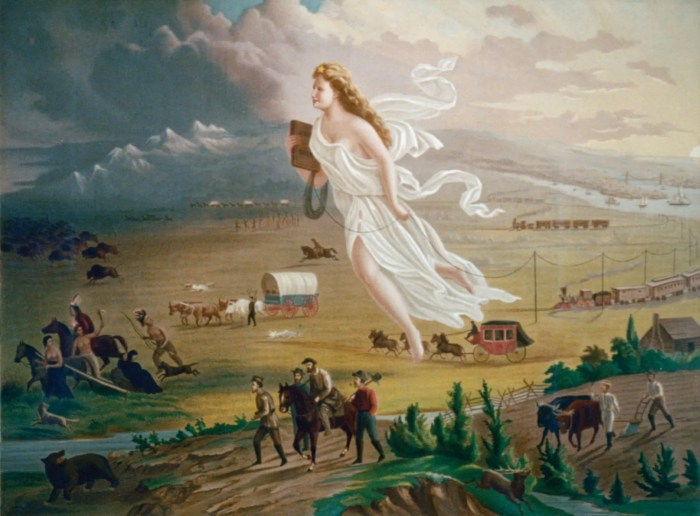
The portrayal of Native Americans in art during this era is deeply problematic and inextricably linked to Manifest Destiny. Many paintings depicted Native Americans as obstacles to progress, often romanticized but ultimately marginalized or demonized. These depictions served to justify the displacement and dispossession of indigenous populations, framing their removal as a necessary step in the nation’s expansion.
The absence of accurate representation of Native American culture and perspectives further reinforced the dominant narrative of Manifest Destiny.
Landscapes as Symbols of National Identity and Expansion
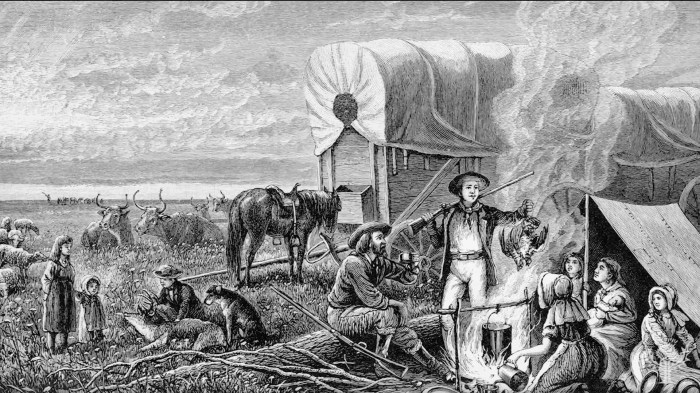
Landscape painting played a crucial role in visually representing Manifest Destiny. The Hudson River School, for example, produced breathtaking panoramas of the American wilderness, often imbued with a sense of sublime beauty and awe. These paintings helped to cultivate a sense of national pride and identity, associating the vast American landscape with the nation’s destiny and potential for growth. The untouched wilderness became a symbol of both the nation’s potential and the inherent right to claim and develop it.
Artistic Representations of the Frontier: A Comparative Table
| Time Period | Artistic Style | Dominant Themes | Representation of Native Americans |
|---|---|---|---|
| Pre-Manifest Destiny (Early 1800s) | Primarily portraiture, some early landscape sketches | Individual portraits, limited landscape scenes focusing on specific locations | Occasional depiction, often generalized and lacking cultural specificity |
| Post-Manifest Destiny (Mid-to-late 1800s) | Hudson River School, Luminism | Westward expansion, sublime landscapes, national identity, progress, the taming of the wilderness | Often depicted as obstacles to progress, romanticized or marginalized, lacking accurate cultural representation |
Artistic Styles and Movements Reflecting Manifest Destiny
Several artistic styles flourished during the era of Manifest Destiny, reflecting and shaping the prevailing ideology. The Hudson River School, Luminism, and other movements provided visual expressions of the era’s dominant themes: progress, civilization, and the taming of the wilderness. This section examines the relationship between these artistic styles and the ideology of Manifest Destiny.
The Hudson River School and Manifest Destiny
The Hudson River School, a prominent American art movement of the mid-19th century, is closely associated with Manifest Destiny. Its artists created large-scale landscape paintings that emphasized the beauty and grandeur of the American wilderness. These works often depicted untouched landscapes, suggesting a sense of limitless potential and reinforcing the idea of the nation’s divinely ordained right to expand.
The vastness and untouched nature of the landscapes were used to promote the idea of American exceptionalism and the inherent right to claim and conquer this land.
Progress and Civilization in Manifest Destiny Art
The concept of “progress” and “civilization” was visually represented in artwork through the depiction of westward expansion as a transformative process. Paintings often contrasted the “untamed” wilderness with scenes of settlement, agriculture, and industry, suggesting a narrative of human improvement and the triumph of civilization over nature. This portrayal often ignored or downplayed the displacement and destruction inflicted upon Native American communities in the process of westward expansion.
Nature in Art: Before and After Manifest Destiny
The portrayal of nature in art changed significantly with the rise of Manifest Destiny. Earlier representations often focused on specific locations or individual elements of the landscape. In contrast, art influenced by Manifest Destiny tended to emphasize the vastness and sublimity of the American wilderness, often using panoramic views to convey a sense of awe and national pride. This shift reflected the changing perception of nature, from a source of sustenance and wonder to a resource to be exploited and controlled.
Contrasting Views on Manifest Destiny Through Art
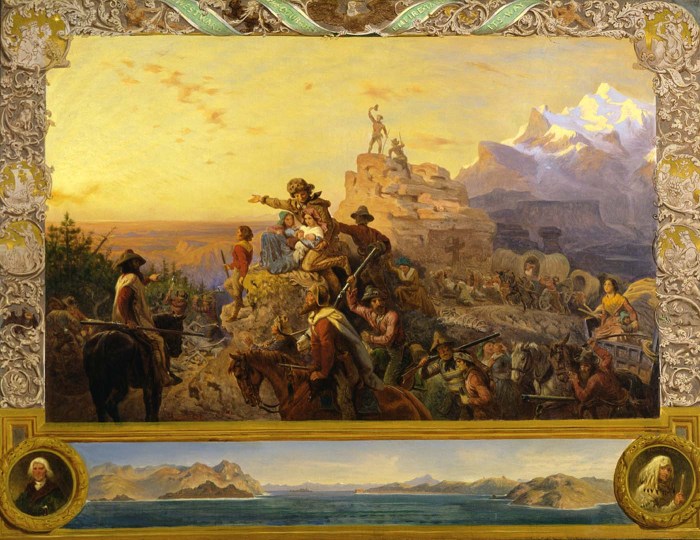
A visual representation contrasting views on Manifest Destiny could juxtapose a large-scale Hudson River School landscape, emphasizing the beauty and potential of the American wilderness, with a smaller, more somber work depicting the consequences of westward expansion, such as the displacement of Native Americans or environmental degradation. The Hudson River School painting would represent the optimistic and expansive vision of Manifest Destiny, while the second work would convey a more critical perspective on its destructive aspects.
The stylistic differences – the grand scale and idealized beauty of the former versus the more intimate and potentially harsh depiction of the latter – would further highlight the contrasting viewpoints.
Manifest Destiny’s Impact on Artistic Patronage and Subject Matter: How Did Manifest Destiny Contribute To Early American Art
Government and private patronage played a significant role in shaping the artistic representations of Manifest Destiny. Commissioned works often served to promote or, in some cases, subtly critique the ideology. This section explores the influence of patronage and the resulting shift in subject matter in both popular and fine art.
Government and Private Patronage
The government, through commissions for official portraits and landscape paintings, actively promoted a positive image of westward expansion. Private patrons, including wealthy individuals and corporations involved in land development and resource extraction, also commissioned artwork that reinforced the narrative of Manifest Destiny. This patronage ensured that the dominant ideology was visually reinforced and disseminated widely.
Commissioned Art: Promotion and Critique
Many commissioned works directly promoted the ideology of Manifest Destiny, depicting westward expansion as a heroic and inevitable process. However, some artists subtly critiqued the ideology through their work. For instance, some landscape paintings might feature subtle elements suggesting the environmental costs of expansion or the displacement of Native American populations. These subtle critiques, often embedded within seemingly celebratory works, offered a more nuanced perspective on the consequences of Manifest Destiny.
Westward Expansion and Subject Matter, How did manifest destiny contribute to early american art
The expansion westward dramatically influenced the subject matter of both popular and fine art. The vast landscapes of the American West became a dominant theme, while depictions of pioneers, settlers, and Native Americans became increasingly common. The focus shifted from primarily portraiture and historical scenes to encompass the broader narrative of national expansion and its associated challenges and triumphs.
Prominent Artists Depicting Manifest Destiny
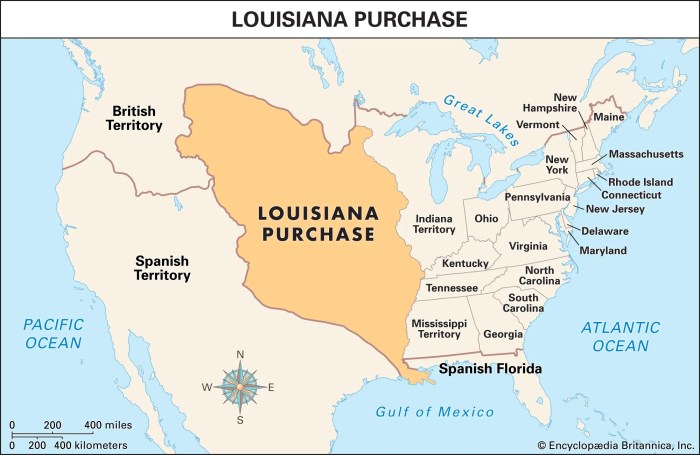
- Albert Bierstadt: Known for his dramatic and romanticized landscapes of the American West, often emphasizing the sublime beauty of the natural world. His paintings, such as “Among the Sierra Nevada, California,” exemplify the grandeur associated with Manifest Destiny.
- Thomas Moran: Another prominent figure in the Hudson River School, Moran’s paintings, such as “The Grand Canyon of the Yellowstone,” captured the awe-inspiring scale of the American West, contributing to the national conversation surrounding westward expansion.
- Frederick Church: Church’s paintings, often featuring exotic and dramatic landscapes, contributed to the romanticized vision of the American West, fueling the sense of national pride and potential associated with Manifest Destiny.
Artistic Representations of the Consequences of Manifest Destiny
While much art celebrated the expansionist narrative of Manifest Destiny, some works also depicted the violence, displacement, and cultural clashes associated with westward expansion. These artistic representations offered alternative perspectives on the consequences of this ideology, sometimes challenging and sometimes reinforcing the prevailing narrative. This section explores these contrasting depictions and their significance.
Violence, Displacement, and Cultural Clashes
Some artists depicted the darker side of westward expansion, showcasing the violence inflicted upon Native American populations, the displacement of communities, and the cultural clashes between settlers and indigenous peoples. These works often presented a more critical perspective on Manifest Destiny, highlighting the human cost of expansion and challenging the celebratory narratives prevalent in other artistic representations.
Challenging and Reinforcing the Narrative
Artistic representations of the consequences of Manifest Destiny could either challenge or reinforce the prevailing narrative. While some works served to justify the expansion by portraying Native Americans as obstacles to progress, others offered a more critical perspective, exposing the brutality and injustice associated with westward expansion. The interpretation often depended on the artist’s perspective and the intended audience.
Environmental Impact in Art
Some artistic works began to reflect the environmental impact of Manifest Destiny, depicting deforestation, resource depletion, and the alteration of landscapes. These works provided a more nuanced understanding of the consequences of westward expansion, highlighting the long-term environmental costs alongside the human costs. These depictions served as early warnings about the unsustainable practices associated with rapid expansion and resource exploitation.
An Imagined Artwork: The Legacy of Manifest Destiny
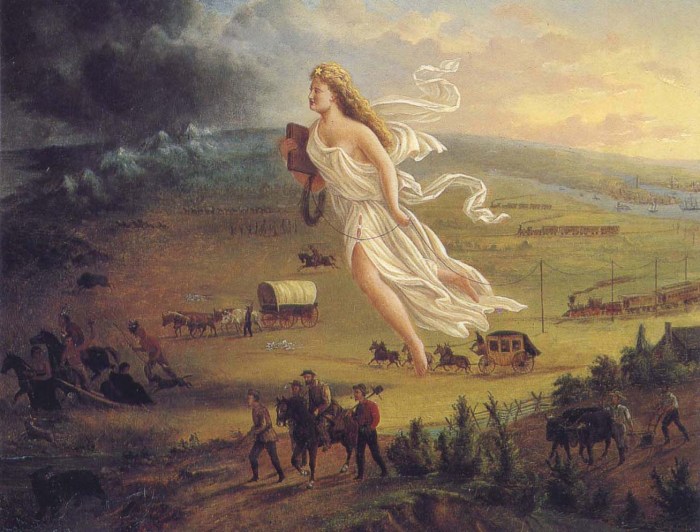
An imagined artwork depicting the complex legacy of Manifest Destiny might feature a vast, panoramic landscape encompassing both the beauty of the American West and the scars left by westward expansion. The color palette would range from vibrant hues representing the untouched beauty of nature to darker, more somber tones reflecting the violence and destruction. The composition might include elements such as a majestic mountain range juxtaposed with remnants of abandoned settlements and the ghostly figures of displaced Native Americans, symbolizing both the grandeur of the land and the tragic consequences of its conquest.
The overall effect would be one of both awe and somber reflection, conveying the multifaceted and complex legacy of Manifest Destiny.
Ultimate Conclusion
Manifest Destiny’s impact on early American art is undeniable. The westward expansion, with its inherent complexities of progress, violence, and cultural clashes, found powerful expression through various artistic movements and styles. From the romanticized landscapes to the more critical depictions of displacement and conflict, the art of this era serves as a crucial visual record of a pivotal moment in American history.
By studying these artistic representations, we gain a deeper understanding not only of the art itself, but also of the profound and lasting consequences of Manifest Destiny on the American landscape, its people, and its national identity.
FAQ Corner
What specific techniques did artists use to depict the vastness of the American West?
Artists employed techniques like panoramic views, dramatic lighting, and detailed rendering of natural features to convey the scale and grandeur of the western landscape, emphasizing its seemingly limitless potential.
How did the rise of photography impact artistic representations of Manifest Destiny?
Photography offered a new form of realism, influencing artistic styles and providing artists with more accurate visual references of the landscape and its inhabitants. However, photography’s own biases and selective framing also played a role in shaping the narrative of westward expansion.
Were there any artistic movements that actively resisted or critiqued Manifest Destiny?
While less prominent than the celebratory representations, some artists subtly or overtly challenged the dominant narrative through depictions of the violence and displacement caused by westward expansion. These works often focused on the suffering of Native Americans and the environmental consequences of Manifest Destiny.